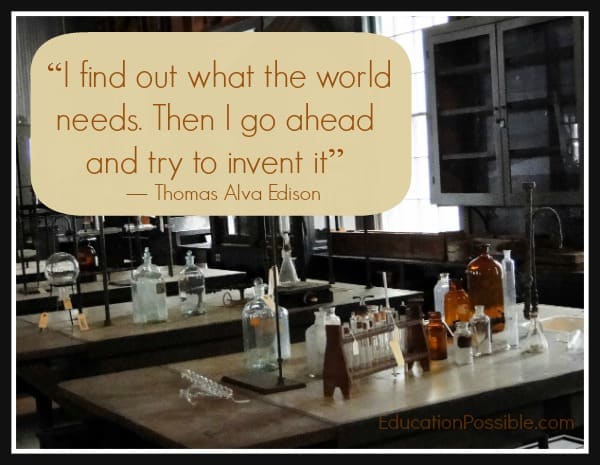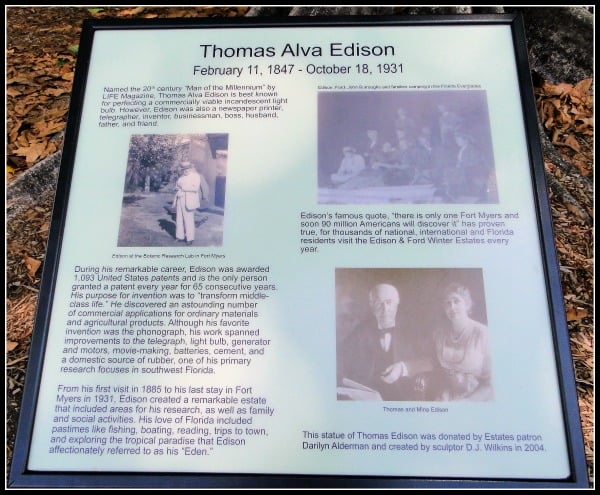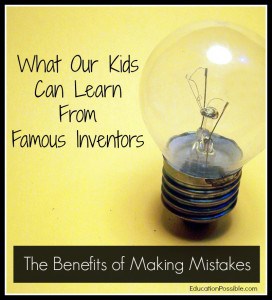The Benefits of Making Mistakes: Lessons from Thomas Edison
Studying the Thomas Edison mistakes is a great way to learn some valuable life skills for teens.
When we studied Edison during our homeschool history lessons we spent time learning about his life and the many contributions he made to society. As my middle school aged children were completing their biography reports they began to learn about some of Edison’s less famous inventions and even some of his failures.
This was a great opportunity to talk about the importance and even the benefits of making mistakes.

“I am not discouraged, because every wrong attempt discarded is another step forward.” – Thomas Alva Edison
First Failure
With more than 1,000 patents to his credit, Edison enjoyed a great deal of success during his lifetime. However, it is important to understand that not everything he created or imagined worked as intended or was well received by the public. In fact, Edison’s first patent ever was his first public failure. In 1868 Edison filed his first a patent for an automatic vote-recording machine. He believed his machine would be of service to members of Congress as he had observed them spending so much time manually counting their votes. Although his machine did work properly, congressmen wasted no time telling Edison they did not want to use his machine because they believed it was necessary to be able to filibuster and delay votes. *It is important to note that decades later a voting system based on Edison’s machines was installed.
Learning From Mistakes
After this public failure Edison wasn’t discouraged. Instead, he got right back to work. What he really wanted to do was solve problems and he believed he could learn from both his successes and his failures. Since he was so determined to find a way to solve problems, Edison eventually built his own invention factory in New Jersey. Surrounded by hundreds of tools, parts, materials, and different types of equipment, Edison’s employees were encouraged to create “a minor invention every ten days and a big thing every six months.” Edison identified problems, brainstormed solutions, thought up new inventions, and built new machines. Some of his ideas were brand new like the phonograph, and others were improvements on existing ideas, like the light bulb. Not all of his inventions worked – he made a lot of mistakes. But many of his inventions did eventually work as Edison was granted at least one new patent each year for 65 consecutive years. 
“After we had conducted thousands of experiments on a certain project without solving the problem, one of my associates, after we had conducted the crowning experiment and it had proved a failure, expressed discouragement and disgust over our having failed to find out anything.
I cheerily assured him that we had learned something.
For we had learned for a certainty that the thing couldn’t be done that way, and that we would have to try some other way.” – Thomas Alva Edison
Mistakes Move Us Forward
As we learned about Edison we also began to have discussions about the invention process and how the kids might be able to apply those steps to their own lives. This is the process we identified and some of the questions we now ask ourselves when faced with a new challenge:
- Identify a problem or need – try to look at it from a different perspective to gather additional information
- Create a solution – do some research, be creative, and try something new
- Test your new solution and make notes about the results
- Evaluate your results and repeat the steps as many times as necessary!
As we began to look at situations this way my kids realized the process was actually a circle rather than a straight line. Meaning, if they tried something and didn’t succeed, they shouldn’t take that as a dead end, rather, it was just a way to start the process all over again with new (and hopefully better) information. My kids now find this process has many applications. My younger son likes to build things so he has put his inventor hat on and designed new toys and contraptions to use around the house. A few actually worked the first time, but most required some re-work which my son completed after gathering new information. My older son chooses to use this process to help solve problems rather than build physical things. For example, when he tried to explain why his math problems are not correct, he state he didn’t get the problem wrong, rather “he was just ruling out some incorrect answers before settling on the correct answer”. 🙂
Resources
If you would like to have conversations with your children about Edison, his inventions, and his inspiring messages about the benefit of learning from our mistakes, here are a few of our favorite resources to help you get started: Thomas Edison on Biography.com – This page includes a short video about another of Edison’s failures – his idea for a concrete house. Thomas Edison for Kids: His Life and Ideas, 21 Activities – Have fun re-creating some of Edison’s successful experiments with 21 different activities to choose from. This is a great way to add a study of inventors and their inventions to your middle school science lesson plans.
Tell us what you think – do your children see the benefits of making mistakes?
The Benefits of Making Mistakes
Join us this week as we take a look at some of our favorite inventors, and their inventions, to understand the successes and failures they encountered and the important lessons they learned along the way.
This post is linked up to the Finishing Strong link-up.

Excellent post! I really enjoyed it. In fact, I feel encouraged personally. I also am going to take his approach and start telling my daughter what your son says, he didn’t get the problem wrong, rather “he was just ruling out some incorrect answers before settling on the correct answer. Love it! Thanks!